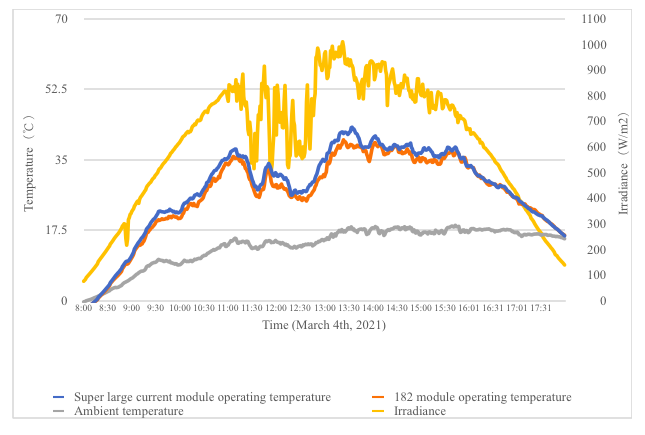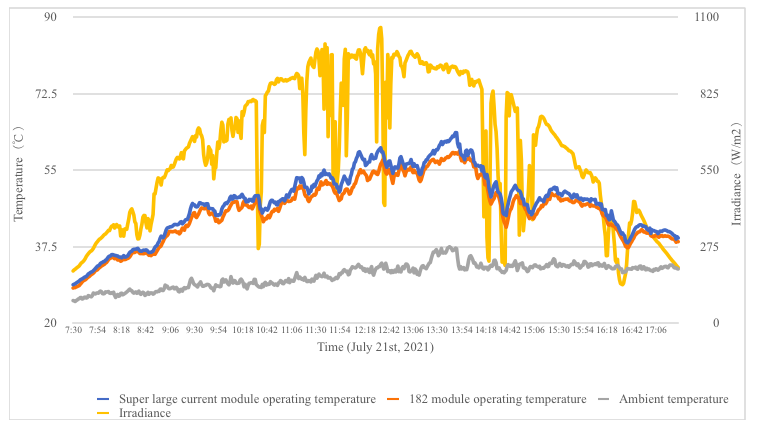To study and verify the power generation and operating temperature performance of different module types, JA Solar and TÜV NORD initiated an energy yield test between February 2021 and February 2022 at the CPVT National Photovoltaic Experimental Base in Yinchuan.
The project was located in Yinchuan, which is typical of a temperate continental climate and arid environment, with average annual peak hours being 1650kWh/m2 (horizontal level), average annual sunshine duration of 2800 – 3000 hours, and an annual average temperature of 8.5 ℃.

The field test plant was equipped with a set of DeepBlue 3.0 monofacial modules (hereinafter 182 modules) and a set of monofacial modules with super-large current (with module short-circuit >18A), with installed power of approximately 7kW (as measured by the field test lab) for each set and an inverter of 20kW for both sets (consisting of two-way MPPT input, one way for each set, with maximum input current being 25A, to ensure no peak clipping in the inverter). A fixed support structure with a fixed tilt angle of 40° was adopted for installing the modules, which were about 1 meter above the ground. In addition to the environmental monitoring system, the project was equipped with a double-sided irradiance meter, a high-precision DC meter and a temperature sensor.
For the PV system design and module energy yield analysis, to avoid the effect of inverters on the power generation performance of different modules only data from the DC meter was used.
A comparison of power generation performance during the full test period, the energy yield performance of JA Solar 182 modules and that of the large current modules is shown in Figure 2.
The average daily energy yield of the two module types was 4.774 kWh/kW and 4.699 kWh/kW respectively, with the 182 modules surpassing the large current modules by about 1.6%.
The power generation capacity of a PV module depends on power degradation, temperature coefficient, low irradiance performance, operating temperature and bifacial generation performance. While both types of module are based on half-cut p-type PERC mono solar cells, they have different operating currents depending on wafer size. The large module employs a 12BB design while the JA Solar 182 module uses an optimized 11BB design.
Theoretically, because the internal resistance loss of a 182 module is relatively lower, differences in power generation performance of the two module types is caused by a disparity in internal resistance loss and the resulting difference in operating temperature.

To verify and analyse the operating temperature differences caused by different module operating currents, we extracted data regarding operating temperature and corresponding radiation intensity of the two types of module in sunny and high-irradiance weather. According to the data shown in figure 3, the average operating temperature of the 182 module is clearly 1.5℃ to 2℃ lower than that of the large current module. When the radiation intensity reduces, both the operating current and temperature of the modules are lowered accordingly. According to theoretical analysis, excessive operating current of a module will cause a significant increase in heat loss on the surface metal contact of the cell, the solder zone and the bus bar. The increase in heat loss will lead to a rising operating temperature, which has been verified by previous analyses based on operating temperature data of half-cut and full PV modules.




To further verify and analyse the relationship between module operating currents and operating temperature, JA Solar and TÜV Rheinland also carried out a field test at the Experimental Base in Hainan. Under conditions of relatively stable irradiance, wind speed and temperature, and selecting a continuous 10-minute period of steady irradiance, the operating temperature of the 182 module and the large current module is shown in figure 4. The operating temperature difference between the two types of module was about 1℃ to 2℃, consistent with the Yinchuan project findings.


